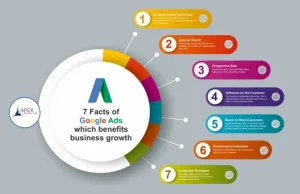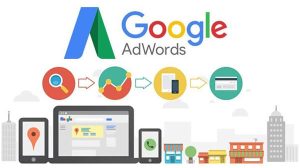Effective Google Ads Marketing: How Does it Work?
Google Ads is a great way for businesses to grow their online profiles and attract relevant website visitors. But how does it work, and what makes it a good marketing tool? Let’s explore the details and see how it works.
What is Google Ads Marketing?
Businesses can advertise search engine results pages (SERPs) and partner websites with it. Businesses bid on topics related to what they’re selling and only pay when people click on their ads. Different ad styles let companies target specific users based on their hobbies and traits, increasing their online exposure and website traffic. It is a cheap way to reach potential customers looking for goods or services. This can lead to more sales and more money because of focused advertising.
Why Place Advertisements on Google?
It is the most popular search engine, with millions of daily searches. The tool has also been around for almost twenty years, giving it some experience and influence in paid advertising.
Companies that compete with you are using it. They may even be bidding on your branded words. Many businesses use this method to promote themselves. Even if you rank naturally for a search term, your outcomes will be pushed down the page below your rivals.
How Do You Use It?
The searcher, the advertiser, and the engine are the three people who work together to make it work. It works because Advertisers and businesses make money, and buyers can find and buy goods and services that meet their needs. Here’s a rundown of what it does behind the scenes:
Keywords are what advertisers bid on.
When marketers bid on keywords, they tell Google which terms they want their ads to appear for in the SERPs. Keyword offers can be as little as a few dollars or as much as several hundred dollars. Advertisers usually set a daily budget to pay for each keyword bid.
You can also make your ads fit your budget, no matter how big or small your business is or how much money you have. The tool lets you see how much you’ve spent on ads each month, enabling you to stop or pause your spending at any time
People who might buy something look for a term on Google.
The possible customer then looks for a topic for which an advertisement has paid. People who search will see ads for goods and services similar to what they were looking for on the SERP. Ad rank has much to do with the order of the ads they see.
Based on ad rank, Google shows ads for that term.
Within the split second that a user types a search query into Google’s search bar and the SERP for that term shows, Google quickly performs a task known as ad rank.
Google quickly sorts advertising from most to least visible based on the number of ad spots on the SERP. To decide who gets to be number one, number two, number three, etc., they look at the keyword quality score and how many ads have bid on the keyword.
The possible customer hits on one of the SERP links to go to a website.
When customers see ads for the term they found, they may choose to click on the one they think best fits what they were looking for.
After that, they might buy something or return to the SERP and pick another ad or a real SERP result to click on. They could also end the search without clicking or buying anything.
Things You Should Know
Ad Extensions:
There is no extra charge for adding more details to your ad with Ad Extensions. There are five groups that these additions belong to: Sitelink, Call, Location, Offer, or App.
AdRank:
Your AdRank tells Google where to put your ad. The more valuable your ad is, the higher it will rank, the more people will see it, and the more likely it is that someone will click on it. Your highest price times your Quality Score tells Google what your AdRank is.
Bidding:
It works with a bidding system. As a seller, you decide how much you will pay for visitors to click on your ad. If you pay more, you’ll get a better spot. You can bid in three ways: CPC, CPM, or CPE.
- Cost-per-click, or CPC, is how much you pay every time someone clicks on your ad.
- CPM, which stands for “cost per mile,” is how much you pay for a thousand views of your ad.
- Cost per engagement, or CPE, is how much you pay when someone does something specific with your ad.
Type of Campaign:
Google Ads marketing agency lets you choose from seven types of campaigns before you initiate a paid campaign: search, display, video, shopping, app, smart, or performance max.
- You can see search ads among the search results on the Google results page. They are text ads.
- Most display ads are pictures on web pages in the Google Display Network.
- There are six- to fifteen-second video ads on YouTube.
- There are shopping ads in search results and on the Google Shopping tab.
- App campaigns utilize data from your app to make advertisements on other websites more relevant to you.
- Google will figure out the best way to target your ads so that you get the most for your money with smart strategies.
- Performance Max is a recent campaign that allows marketers to see all of its inventory in a single campaign.
Click-Through Rate (CTR):
Your click-through rate (CTR) is the number of clicks on your advertisement as a percentage of overall views. A higher CTR means the ad is effective because it matches the search purpose and targets relevant keywords.
Conversion Rate (CVR):
The CVR shows the number of form responses you get as a percentage of all visitors to your landing page. A high CVR means your landing page delivers on the ad’s promise.
Display Network:
It can appear on search results or any Google Display Network (GDN) web page. As part of GDN, websites offer space on their pages. These ads, which can be text or images, appear next to content related to your goal terms. Google Shopping and app ads are the most popular types of Display Ads.
Impressions:
Your ad gets a mark every time it shows up on the SERP. Some merchants and marketers call these “eyeballs” on the ad more casually. One part of the CTR equation we talked about above is impressions. You can use views to determine how many people who see your advertisement click through to your landing page. This will help you improve your ad and get a better CTR.
Remember that it’s virtually impossible to convert all impressions to clicks and achieve a 100% CTR. People might not click on your ad (zero-click search) but instead click on a competitor’s ad or a local search result.
Keywords:
When someone types a question into Google’s search field, the company returns a list of results that match what the person typed. These words or sentences match what a searcher is looking for and answer their question. You choose buzzwords based on the search terms you want your ad to show up with. If someone puts in “how to clean gum off shoes,” for instance, they will see ads for companies that use terms like “gum on shoes” and “clean shoes.”
There is a list of keywords that you want to avoid ranking for. If you bid on these terms, Google will take you out of the running. Often, these are tied to the search terms you want to rank for but not exactly what you give or want to rank for.
PPC:
PPC stands for “pay-per-click.” In this type of advertising, the business pays every time someone clicks on their ad. Paid-per-click (PPC) is the most popular type of paid ad. Before you start your first Google ads marketing agency campaign, you should learn everything there is to know about pay-per-click (PPC).
Quality Score (QS):
Your Quality Score tells you how good your ad is by looking at your click-through rate (CTR), how relevant your keywords are, how good your landing page is, and how well you’ve done in the past on the SERPs. One thing that affects your AdRank is your QS
Final Thoughts:
Businesses that want to make the most of their online footprint and get results need to understand how Google Ads marketing works. It is a powerful tool for precisely and effectively reaching potential customers. It lets you do everything from phrase targeting to ad copy optimization, price management, and group targeting. As one of the best digital marketing service providers, ITcado knows how to help businesses reach their marketing goals by making the most of it. Our knowledge and commitment to excellence make it easy for companies to handle the complicated advertising world. This opens up new ways for them to grow and succeed online.



